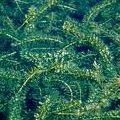- By New York State Governor's Office
- News
 Print
Print  Last week Governor Andrew M. Cuomo announced the launch of an innovative new pilot project to combat harmful algal blooms - or HABs - and return clean water to the Village of Southampton's Agawam Lake. The pilot is directed by the New York State Department of Environmental Conservation and the Office of General Services in partnership with the Village of Southampton. The pilot project is part of the State's $82 million initiative to study, respond to and prevent HABs in New York waterbodies. If the pilot in Agawam Lake proves successful, it will be applied statewide. The Governor launched the HABs initiative in 2018 with $65 million in state funding.
Last week Governor Andrew M. Cuomo announced the launch of an innovative new pilot project to combat harmful algal blooms - or HABs - and return clean water to the Village of Southampton's Agawam Lake. The pilot is directed by the New York State Department of Environmental Conservation and the Office of General Services in partnership with the Village of Southampton. The pilot project is part of the State's $82 million initiative to study, respond to and prevent HABs in New York waterbodies. If the pilot in Agawam Lake proves successful, it will be applied statewide. The Governor launched the HABs initiative in 2018 with $65 million in state funding."Safeguarding New York's water quality is a top priority and we are providing direct assistance to communities to swiftly and effectively respond to harmful algal blooms," Cuomo said. "We are deploying new and innovative tools like the HABs harvester to address the algal blooms in Agawam Lake, and will continue exploring the latest technology to eliminate these blooms altogether and keep waterbodies around the state clean and safe. If this pilot works, then we will bring it up to scale and apply it across the state wherever possible."
The mobile algae harvester will separate algae and other substances from the water and return the resulting filtered and improved water to the lake to abate the HAB. The algae harvester uses technology that is often employed within drinking water plants.
Department of Environmental Conservation (DEC) Commissioner Basil Seggos said, "DEC scientists and water quality experts, and our state and local partners, are investigating the causes of algal blooms across the state and pioneering cutting edge solutions to respond to these blooms and the threat they pose to New York's waterbodies. Today's launch of this new pilot project in Agawam Lake will advance New York's efforts to address these potentially toxic algal blooms."
Agawam Lake, a scenic recreational park in the village of Southampton, is suffering from algae blooms that threaten the lake's water quality. HABs have been reported in the lake each year since at least 2013. This algae harvester, which has been used successfully in other states, is being piloted in New York to see if it will help remove algae from the lake. The algae harvester will be temporarily installed at Agawam Lake Park and is expected to be operational for two weeks. DEC will sample and closely monitor the lake for changes while the pilot project is being conducted.
Most algae blooms are harmless. However, exposure to toxins and other substances from certain HABs can make people and animals sick. The increasing frequency and duration of HABs also threatens water quality and recreational use of waterbodies essential to ecosystem health and statewide tourism. HABs have been detected in more than 400 water bodies since 2012. To address HABs, DEC works with the State Department of Health, OGS, Office of Parks, Recreation and Historic Preservation, and other state and local partners. DEC and the DOH continue to lead the most comprehensive HABs monitoring and reporting program in the nation. Hundreds of waterbodies are monitored annually by DEC, DOH, State Parks, academic institutions, and volunteer monitoring partnerships. In addition, DOH public health protections includes oversight of regulated beaches and public water systems.
When it comes to HABs, DEC encourages New Yorkers to "KNOW IT, AVOID IT, REPORT IT." KNOW IT - HABs vary in appearance from scattered green dots in the water, to long, linear green streaks, pea soup or spilled green paint, to blue-green or white coloration. AVOID IT - People, pets and livestock should avoid contact with water that is discolored or has algal scums on the surface. REPORT IT - If members of the public suspect a HAB, report it through the NYHABs online reporting form available on DEC's website. Symptoms or health concerns related to HABs should be reported to DOH at This email address is being protected from spambots. You need JavaScript enabled to view it.
While the exact cause of HABs is not fully understood, HABs usually occur in waters high in phosphorus and/or nitrogen. New York State has many programs and activities to reduce phosphorus and nitrogen from entering the water from surrounding lands, including stormwater permitting programs, funding for water quality improvement projects, and a nutrient law that restricts the use of phosphorus lawn fertilizer.
New York State's HABs program works with partners to identify, track, and report HABs throughout the state, and communicate health risks to the public. This spring, DEC launched a new NYHABS reporting system that allows both the public and trained algal bloom samplers to send reports of HABs to DEC electronically via a simple, user- and mobile phone-friendly form. These reports, once evaluated by DEC and DOH, are posted to the NYHABS page.
v15i38



